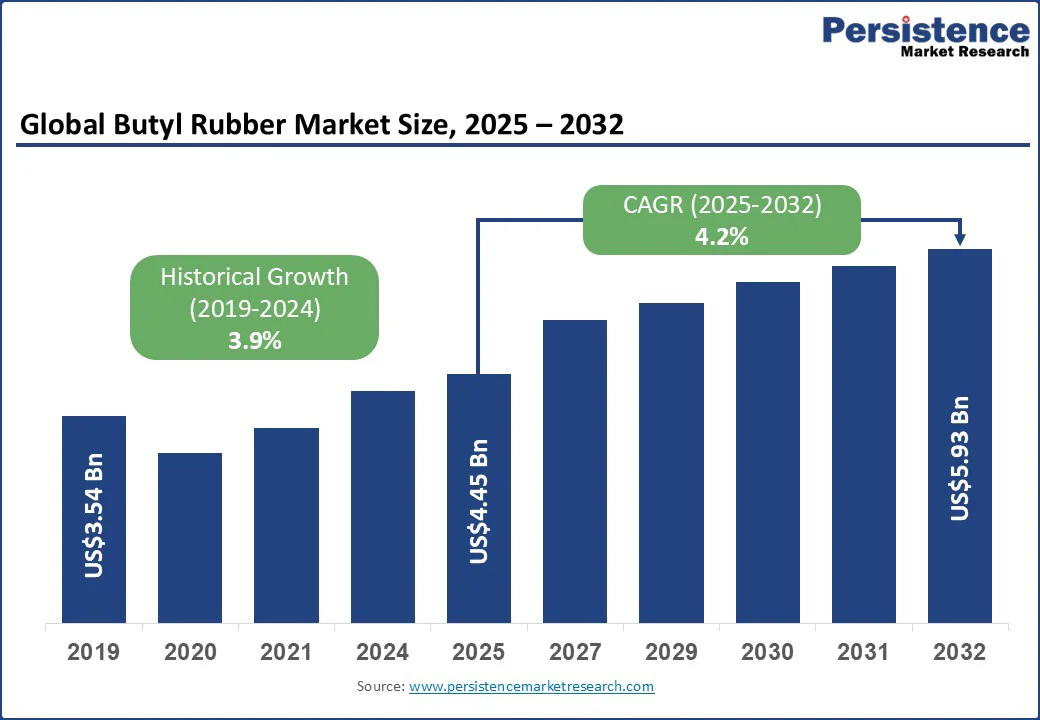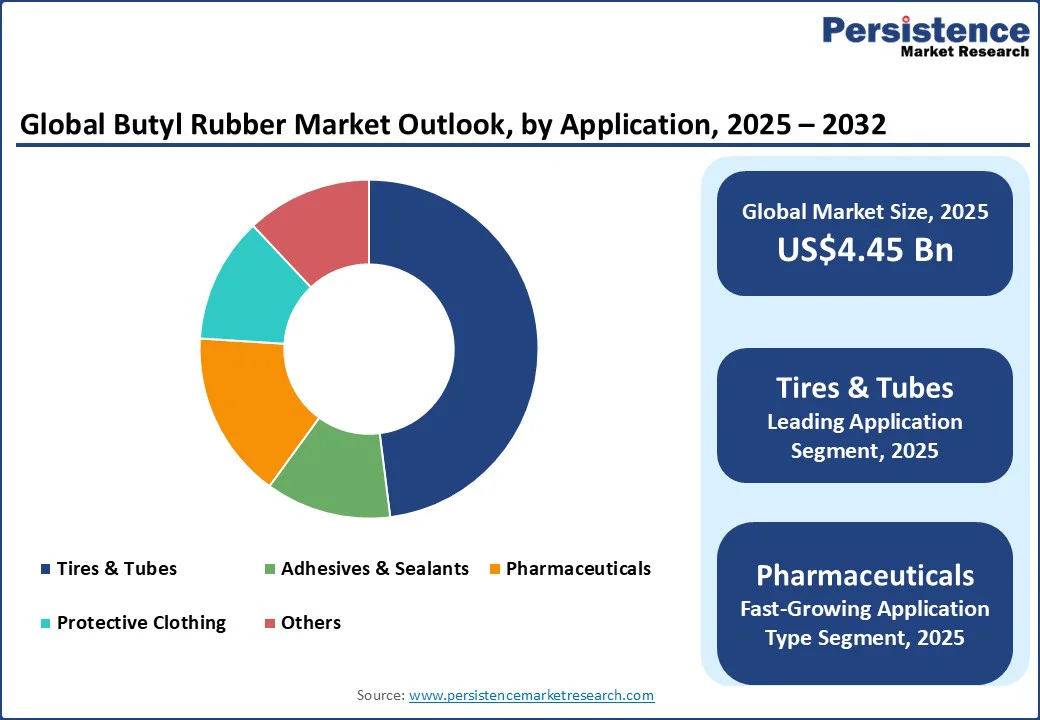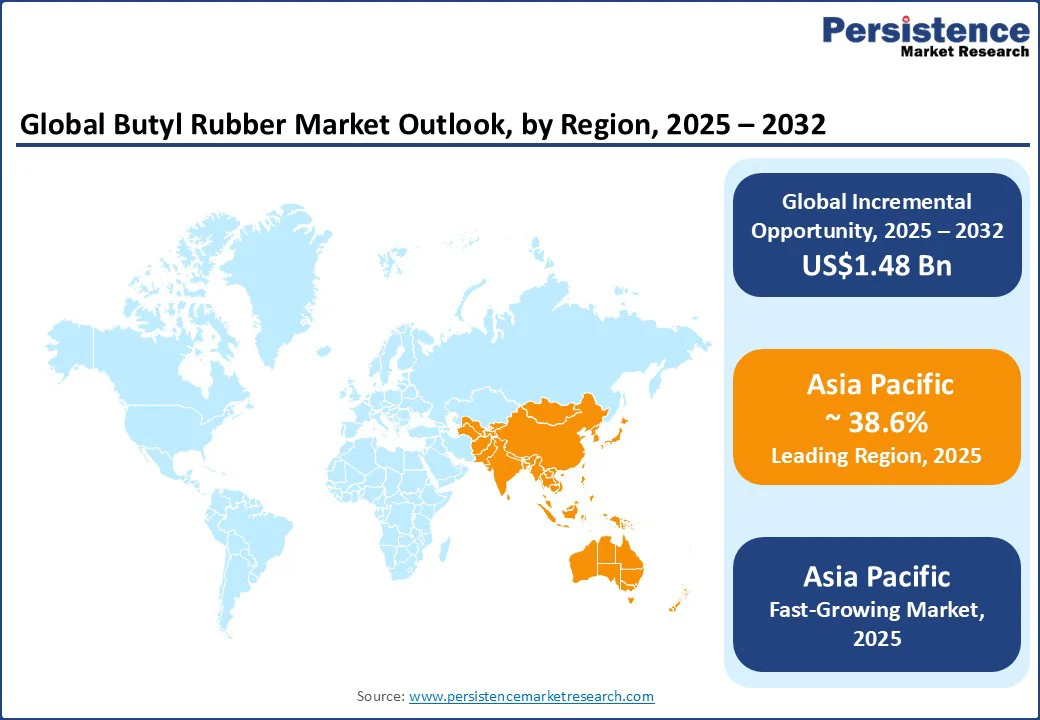ID: PMRREP21742| 194 Pages | 22 Sep 2025 | Format: PDF, Excel, PPT* | Chemicals and Materials

The global butyl rubber market size is likely to be valued at US$4.45 Bn in 2025 and expected to reach US$5.93 Bn by 2032, growing at a CAGR of 4.2% during the forecast period from 2025 to 2032. It is primarily driven by extensive use in tire manufacturing, adhesives, sealants, and protective clothing.
Known for its superior air retention, chemical resistance, and flexibility, butyl rubber has become indispensable in the automotive sector, primarily for inner liners of tubeless tires, which enhance fuel efficiency and safety.
Key Industry Highlights:

| Key Insights | Details |
|---|---|
| Butyl Rubber Market Size (2025E) | US$4.45 Bn |
| Market Value Forecast (2032F) | US$5.93 Bn |
| Projected Growth (CAGR 2025 to 2032) | 4.2% |
| Historical Market Growth (CAGR 2019 to 2024) | 3.9% |
The butyl rubber market is driven primarily by the accelerating shift toward electric vehicles (EVs), where performance and efficiency place greater emphasis on tire technology. Halogenated butyl inner liners are becoming critical in low-rolling-resistance tires due to their ability to significantly lower air permeability compared to natural rubber. This characteristic ensures consistent tire pressure, which directly influences energy efficiency and driving range in electric cars.
With global EV adoption expected to rise sharply over the next decade, the reliance on specialized butyl compounds that support air retention and enhance tire longevity is expanding. For instance, brominated butyl ionomers used in premium EV tires have shown better crack resistance and adhesion, delivering longer service life and higher performance standards.
Green building regulations are stimulating the adoption of butyl-based roofing sealants and glazing membranes that provide long-term adhesion and weather resistance under varying thermal cycles. These niche applications highlight how butyl rubber’s specialized characteristics align with regulatory and performance requirements across industries, strengthening its role in diverse high-value markets.
The market continues to face supply challenges linked to the highly specialized production process and dependence on refinery by-products. Manufacturing halogenated butyl rubber requires ultra-low temperature reactor systems that are prone to mechanical issues, and any operational failure can halt production for extended periods.
In one instance, an equipment breakdown in South Korea disrupted nearly 8% of global capacity, underscoring the vulnerability of the supply chain. At the same time, isobutylene feedstock availability is shrinking as refineries in regions such as Europe reduce output or shut down older units, creating volatility in raw material sourcing and making it difficult for producers to maintain a consistent supply.
Growth in renewable energy and sustainable materials is opening new avenues for butyl rubber manufacturers. UV-stable halobutyl rubber blends are increasingly being adopted in solar panel frame sealants, where long-term resistance to sunlight and weathering is critical for outdoor installations. At the same time, the development of bio-based butyl rubber using biomass-derived isobutylene is gaining traction, offering producers a way to align with green product portfolios.
Recycling and devulcanization technologies are also creating value by enabling the use of reclaimed butyl in secondary applications such as automotive liners and industrial sealants, reducing wastage while expanding product versatility.
Industrial growth in emerging markets is further boosting demand for advanced waterproofing and sealing solutions. Pre-coated butyl roofing membranes designed for regions with heavy rainfall, such as Southeast Asia, are being widely used for their strong adhesion and low moisture permeability.
The biopharmaceutical industry is also presenting high-value opportunities, particularly with the rising need for USP-Class-VI-compliant halobutyl stoppers and closures that safeguard sensitive injectable drugs. Companies capable of delivering high-purity and specialized grades are well-positioned to capture this demand, especially as global healthcare systems scale up biologics and vaccine production.
Regular butyl rubber is anticipated to represent the largest share of the global market, accounting for nearly 47.8% of the market. Its leadership is rooted in its superior impermeability and elasticity, properties that make it indispensable for tire inner liners, adhesives, and general-purpose sealants. Automotive manufacturers rely on regular butyl for its ability to maintain consistent air pressure in tires, which directly impacts fuel efficiency and safety.
Beyond the automotive sector, its wide availability and cost-effectiveness compared to halogenated grades strengthen its adoption across construction and consumer goods. The scale of demand in mass applications, combined with its affordability, ensures that regular butyl rubber continues to hold a dominant position in the product landscape.
Bromobutyl butyl rubber is emerging as the fastest-growing product type. Its growth is driven by advanced performance requirements in both automotive and pharmaceutical applications. Bromobutyl rubber offers superior thermal stability, chemical resistance, and adhesion, making it ideal for high-performance tires that need to withstand extreme conditions while delivering long service life.
In healthcare, bromobutyl stoppers and closures are in rising demand due to their low extractables profile, which safeguards biologics and injectable therapies from contamination. The global shift toward vaccines and specialty drugs has further boosted its adoption, creating lucrative opportunities for suppliers capable of producing pharmaceutical-grade bromobutyl rubber.
For example, leading packaging manufacturers have incorporated bromobutyl closures into vaccine vials to ensure product integrity under cold-chain storage, underscoring the segment’s role in high-value industries.
Tires and tubes are anticipated to account for nearly 59.3% of total butyl rubber consumption, making this the most dominant application. This segment leads due to butyl rubber’s unique impermeability, which prevents air loss and improves tire safety, durability, and efficiency. Automotive growth in emerging economies, such as India and China, continues to fuel demand, while developed markets contribute through the expansion of EVs.
EV manufacturers place a premium on tire technologies that enhance range and performance, positioning butyl rubber as a strategic material. A single percentage drop in tire pressure can reduce energy efficiency significantly, making the air retention quality of butyl rubber indispensable. This highlights how closely the industry is tied to global vehicle production trends, from conventional cars to next-generation EVs.
Among application, pharmaceuticals are showing the fastest growth rate as biologics, injectable therapies, and vaccines become central to modern healthcare. Butyl rubber is essential in closures and stoppers for vials, syringes, and infusion systems, where it provides a sterile barrier against oxygen and moisture ingress.
With regulators tightening standards on drug packaging integrity, demand for halogenated butyl grades has accelerated, particularly bromobutyl rubber, which offers low extractables and strong chemical compatibility.
This shift is especially visible in the biologics segment, where product sensitivity requires packaging materials with minimal risk of leaching or contamination. A relevant example is the increased adoption of bromobutyl stoppers in COVID-19 vaccine packaging, which highlighted the material’s importance in ensuring long-term drug stability and safety.

Asia Pacific is projected to be both the largest and the fastest-growing region in 2025, accounting for 38.6% of the market share. The region’s dominance is anchored in its massive automotive industry, construction growth, and rising healthcare investments. China leads global consumption, fueled by its position as the world’s largest tire producer and consumer.
The country’s expanding EV fleet has amplified demand for halogenated butyl rubber, which offers superior durability and air retention for high-performance tires. In addition, government initiatives such as anti-dumping investigations on imported halobutyl rubber underscore China’s strategy to safeguard domestic producers and strengthen its local supply chain.
India is emerging as one of the fastest-growing markets within the Asia Pacific, driven by rising vehicle sales, infrastructure development, and increasing demand for pharmaceutical closures. The country’s strong focus on expanding its healthcare sector and vaccine production capacity has created an opportunity for bromobutyl rubber in medical packaging applications.
The growth of India’s tire manufacturing sector, supported by both domestic and global OEMs, has made the country an attractive hub for butyl rubber suppliers. Asia Pacific’s broad industrial base and rapidly expanding healthcare infrastructure make it the most dynamic growth center for butyl rubber globally.
North America continues to hold a significant position in the market, supported by its strong automotive base and advanced healthcare infrastructure. The region accounts for over one-third of global demand, with the U.S. serving as the primary growth engine.
The rising expansion of EVs in the U.S. has elevated the demand for butyl rubber in high-performance tires, seals, and adhesives that contribute to energy efficiency and vehicle safety. Federal investments in EV manufacturing plants, coupled with a rebound in automotive production volumes, have translated into higher consumption of regular and halogenated butyl rubber grades.
Beyond automotive applications, the region’s pharmaceutical sector is another major contributor, with growing demand for bromobutyl closures and stoppers used in injectable therapies and vaccines.
The U.S. dominates regional consumption, underpinned by a vast tire replacement market and steady demand for high-purity pharmaceutical packaging materials. In 2023, tire shipments exceeded 330 million units, highlighting the enduring role of aftermarket demand in driving butyl rubber consumption.
Canada, though comparatively smaller, is accelerating as the country scales up investments in pharmaceutical manufacturing and packaging solutions. With Canadian companies increasingly aligning with the FDA and EU standards, the adoption of halobutyl rubber for sterile closures and medical devices is rising steadily.
Europe demonstrates stable growth in the butyl rubber market, with demand driven primarily by its automotive and pharmaceutical industries. Stringent environmental regulations and strict performance requirements create a market for high-quality halogenated butyl rubber grades. Germany anchors regional demand, leveraging its advanced automotive manufacturing capabilities.
German OEMs are incorporating bromobutyl and chlorobutyl rubber into high-performance tire applications, ensuring compliance with EU emission and fuel economy mandates. German chemical companies are investing in sustainable production technologies to align with the European Union’s carbon reduction and REACH compliance standards, further shaping the future of butyl rubber production in the region.
France and the U.K. represent other important markets, with strong emphasis on pharmaceutical applications. Demand for USP-Class-VI-compliant halobutyl rubber stoppers and closures has increased, supported by a growing biologics and vaccine pipeline across both countries.
The U.K. is also adopting butyl rubber-based adhesives and sealants in construction projects aligned with green building standards, expanding the material’s use beyond automotive and healthcare. Europe’s emphasis on high-value, sustainable, and compliant materials ensures that the region remains a critical market for specialty butyl rubber.

The global butyl rubber market is highly competitive, dominated by a mix of large multinational chemical companies and regional producers focused on specialty grades. Key players such as ExxonMobil, Lanxess AG, Lubrizol, Sinopec, JSR Corporation, Kumho Petrochemical, and Tosoh Corporation leverage advanced manufacturing capabilities, strategic partnerships, and R&D investments to maintain market leadership.
Competition is intensified by the growing demand for halogenated butyl rubber in automotive and pharmaceutical applications, prompting companies to innovate with higher-performance grades, bio-based feedstocks, and recycled content.
Regional expansions, joint ventures, and capacity enhancements are common strategies, while differentiation through product quality, regulatory compliance, and sustainability credentials has become a decisive factor in capturing high-value contracts and long-term customer loyalty.
The butyl rubber market size is estimated to be US$4.45 Bn in 2025.
The butyl rubber market is expected to reach US$5.93 Bn by 2032.
Key trends include rising demand for halogenated butyl rubber in high-performance automotive tires and pharmaceutical closures, and increasing investments in production capacity in Asia Pacific and North America.
Regular Butyl Rubber is the leading product segment, holding nearly 47.8% of the global market due to its cost-effectiveness and widespread use in tire inner liners, adhesives, and sealants.
The butyl rubber market is projected to grow at a CAGR of 4.2% from 2025 to 2032.
Leading players include ExxonMobil, Lanxess AG, Lubrizol Corporation, Sinopec, and JSR Corporation.
| Report Attribute | Details |
|---|---|
| Historical Data/Actuals | 2019 - 2024 |
| Forecast Period | 2025 - 2032 |
| Market Analysis | Value: US$ Bn |
| Geographical Coverage |
|
| Segmental Coverage |
|
| Competitive Analysis |
|
| Report Highlights |
|
By Product Type
By Application
By End-use Industry
By Region
Delivery Timelines
For more information on this report and its delivery timelines please get in touch with our sales team.
About Author